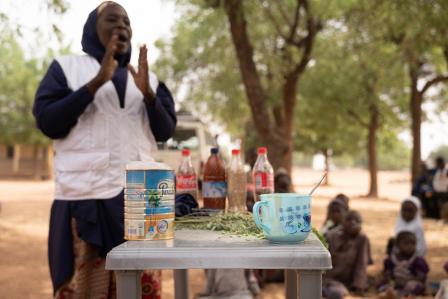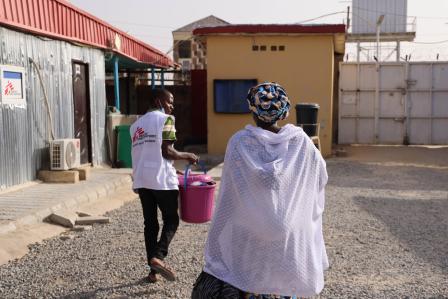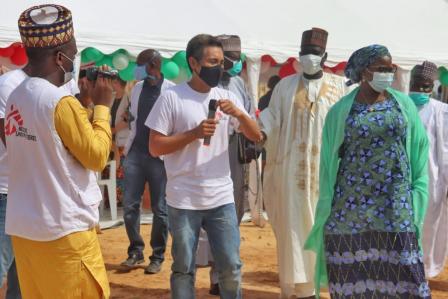Nigeria: Catastrophic malnutrition crisis in northwest must be recognised

A medical staff measuring brachial circumference of a severely malnourished child at the Doctors Without Borders Kofar Marusa ambulatory therapeutic feeding centre, Katsina State. Nigeria, June 2022. © George Osodi
Abuja: As the malnutrition crisis in northwest Nigeria continues at catastrophic levels, Doctors Without Borders / Médecins Sans Frontières (MSF) is calling for the humanitarian community to respond to the emergency needs of people in the region, and for northwest Nigeria to be included in the UN’s humanitarian response plan, enabling a broader and more sustained response.
Since the beginning of 2022, Doctors Without Borders teams have witnessed extraordinarily high numbers of children with malnutrition in Doctors Without Borders' programs located in five states across northwest Nigeria. Multiple factors have led to a sharp increase in malnutrition in the region over last year.
With increasing insecurity, climate change and global inflation of food prices in a post-pandemic world, we can only imagine this crisis getting worse. The Nigerian authorities need support to deal with a crisis of this magnitude. This must include emergency humanitarian funding now for organisations able to respond and a commitment to include northwest Nigeria in the UN’s humanitarian response plan for 2023.Dr. Simba Tirima, Country Representative
Since January, Doctors Without Borders teams working in collaboration with the Nigerian health authorities have treated close to 100,000 children suffering from acute malnutrition in 34 outpatient facilities and admitted about 17,000 children requiring hospital care in 10 inpatient centres in Kano, Zamfara, Katsina, Sokoto and Kebbi states.
In Zamfara state, one of the areas most affected by ongoing violence and banditry, we recorded a 64 percent increase in the numbers of severely malnourished children treated in the outpatient nutritional departments supported by Doctors Without Borders from January to August 2022 when compared to January to August 2021.
Doctors Without Borders’ nutritional surveys have also underlined the severity of the crisis, including in areas that are less affected by violence and insecurity. In Mashi local government area, in Katsina state, Doctors Without Borders found a 27,4% rate of global acute malnutrition and a 7,1% rate of severe acute malnutrition in June, even though the community has been relatively spared from violence and forced displacement. These rates indicate a critical emergency.

Stabilization ward at an Doctors Without Borders-run intensive therapeutic feeding centre (ITFC) in Maiyama General Hospital, Kebbi. Nigeria, 19 July 2022. © KC NWAKALOR
The UN’s current humanitarian response plan for Nigeria focuses on the critical situation in the country’s northeast region, excluding the northwest. Unlike Doctors Without Borders, which is not funded by the humanitarian response plan, many organisations are currently unable to respond to the acute needs in the northwest because they rely on it for funding.
“We understand the United Nations, donors and other stakeholders are increasingly aware of the extent of the crisis in the northwest, but there is a need to go beyond discussions,” said Froukje Pelsma, Doctors Without Borders head of mission in Nigeria. “It’s essential that the northwest is included in the next Nigeria humanitarian response plan for 2023, because this plays a key role in mobilising the resources to save lives.”




